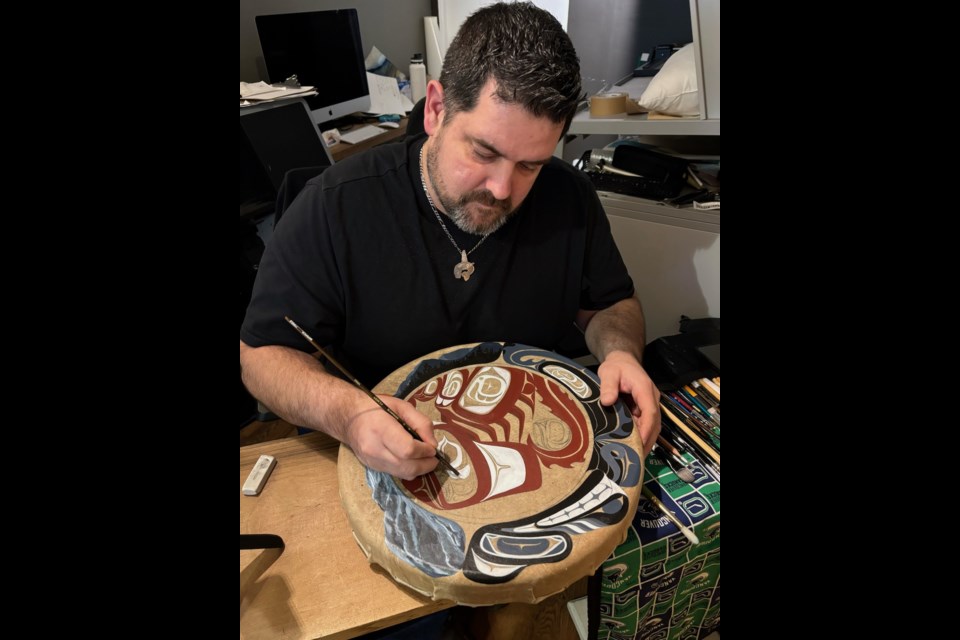This story was originally published in Coast Reporter's winter edition of Coast Life magazine.
Imagine a kayaker paddling with a friend off Haida Gwaii. Without warning, a killer whale surges out of the water about 12 metres away. After exhaling through its blow hole, the bold blackfish swims under their kayaks. They freeze. Will it swamp their boats? It never reappears. Yet, as they look towards K’il Kun (Sandspit), they see orcas pulling seals off rocks in a turbulent thrash of shoreline hunting.
When Tahltan artist and carver Levi (Mala) Purjue had this surprising encounter in 2017, he immediately painted the scene. For this Chi’yone (wolf ) clan member, a killer whale or “sea wolf” is far more than an impressive creature. In one large, evocative painting, an orca swims between two submerged totem poles that symbolize part of a previously inhabited coastline village. Levi says this blackfish protects Indigenous culture stripped away by colonialism and residential schools.
As resident artist at Silver Moon Gallery in Lower Gibsons, Levi reaffirms that First Nations culture is reviving. In an online comment that accompanies his orca painting Tatlan Tu (“Deep Water”), he says: “I am happy to be contributing … to keeping this part of my heritage alive and growing forward.”
Like his carvings, Levi’s acrylic paintings use Northwest Coast forms to convey nature’s wild power. They honour an array of sea-dwellers, from orcas and humpbacks to salmon and a narwhal. From the skies, you’ll find a raven, bald eagle, hawk and barn owl. A wolf image is his only chalk pastel drawing, inspired by Welsh wildlife artist Jason Morgan.
In a four-part series of paintings, Levi pays homage to the Golden Spruce, a 50.3-metre-high Sitka spruce considered sacred by the Haida, which he canoed past many times while growing up on Haida Gwaii. Immortalized in John Vaillant’s book The Golden Spruce, this rare, shimmering tree was felled in 1997 by rebel Grant Hadwin to protest the logging industry.
As an artist, Levi is wholly self-taught. He started out as a musician, getting his first electric guitar at age 12. “I was no good,” he says with a laugh. Later, playing mostly folk and rock, he performed at festivals with bands. (You can see him perform with his acoustic guitar in Gibsons at Tapworks’ open mic sessions on the last Thursday of every month.)
It wasn’t until a serious back injury from a 2015local car accident, which required three months of rehabilitation following surgery, that Levi started painting. Unable to continue construction work and bored at home watching too much TV, he went to the Dollar Store, bought a small easel and canvas and began. He admits that previously, he wasn’t the best drawer and considered school art classes “an easy grade to pass.” Yet, three months after this raw beginning, he had his first painting displayed in Gibsons’ Sunnycrest Mall gallery.
He says now: “I always loved native art. I never thought it was something I could do.” Levi sold multiple pieces at our recent Art Crawl, including a moss wall that combines his painting with preserved moss art by Silver Moon Gallery owner Monica Ardiel. He exhibits works at the Silver Moon and at Coastal Carvings Gallery in Coombs, B.C.
As a carver in yellow and red cedar, Levi apprenticed with Homalco artist Derek Georgeson in ch’atlich (Sechelt). The two worked together almost daily for about five years. Levi, Derek and Derek’s weaver wife Shyanne Watters each displayed original works in the exhibition Texem-ay (Red cedar) at the Sunshine Coast Arts Centre in August 2019.
Levi’s carved canoe paddles offer exquisite, complex designs, ranging from a halibut with jade eyes to thunderbird, eagle and salmon figures embellished with inlays of copper, abalone and operculum. Whether an octopus, crow, heron, hummingbird, frog—or a silver moon—Nature appears in fluid stop-motion, suggesting a momentary glimpse of swirling life.
One poignant carved piece is a large vertical feather depicting silhouettes of his maternal grandmother Jean Ward, the eldest of three children at age eight, standing hand-in-hand with her siblings in front of a residential school. She attended three such schools: in Carcross and Dawson City in the Yukon, and in New Westminster. Each child bears their assigned number: 56 for Levi’s grandma, and 57 and 58, respectively, for the others.
Besides carving masks, feathers and distinctive wall panels, Levi has worked with Derek on a 3 x 1-metre (10 x 3-foot) totem pole depicting a grandfather killer whale and an eagle. He has appeared on Coastal Carvings, a documentary series that began last year on the Aboriginal Peoples Television Network. He’ll be on screen again for season two, likely in the new year.
In his early teens, Levi moved with his mother to the Sunshine Coast from Haida Gwaii after his parents split up. He calls both those islands and our local area home. “I love this place,” he says.



